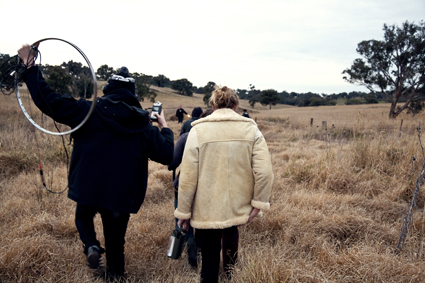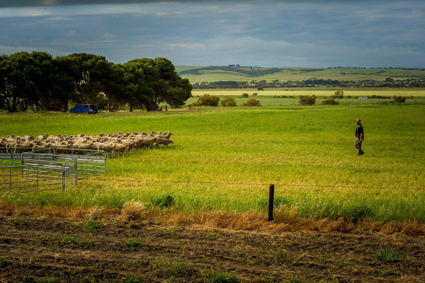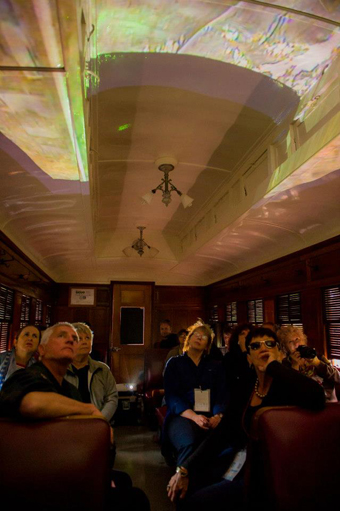 |
Participants in the field with their bike loop antennas during the Haines & Hinterding Fields of Frequency workshop, Wired Lab, July 2011, photo Sofie Muceniekas, Shoot at Everyone Imaging |
Last was a member of the Wagga Space Program Collective, producer of the unsound festivals (2000-2006). She took over the reins in 2003, curating ambitious site-specific events such as Mutable Landscapes (2004), a residency program bringing national and local artists together to work on site-based artworks, and Locomotivus (2006), a performative train journey (a format Last has continued to explore). The Wired Lab can be seen as the logical extension of these activities. Last and Burraston met during Locomotivus; the year after he made the move to the country. Originally from the UK, Burraston is an artist, scientist and composer with extensive knowledge in generative systems and what he terms “creativity and complexity.”
On-site and wired up
Last started Wired Lab in 2008 with one of the inaugural ArtLab grants from the Australia Council. To bring a curatorial focus to the early projects the lab focused on the creation of long wire instruments pioneered by West Australian artist Alan Lamb, also involving guest artists such as David Burraston, Oren Ambarchi, Robin Fox and Garry Bradbury. Last explains, “the seed funding was oriented around the wire instruments and a desire to construct some of those and work with a team of artists to investigate them. That area of work was really connecting with what I’d already been doing in terms of landscape-scale practice and working outside of institutional constructs in the open field. While a lot of the early work was aligned around wire instruments, the project itself is broader than that, exploring old and new media and interdisciplinary experimentations…Essentially I want Wired Lab to be a platform of activity for contemporary art research and practice in a regional context. I’m also interested in exploring different models of operation for artist-run collectives.”
A particular focus of the Wired Lab is on skills and development. Across the year, it offers intensive masterclasses and workshops for both local and national artists in various areas of sound creation and arts production. Often these are led by visiting international artists undertaking residencies at the lab, such as renowned field recordists Chris Watson (UK), Jez Riley-French (UK) and Douglas Quinn (US). Last explains, “In terms of the artists we work with there’s got to be a reciprocal interest—and the conversation really goes from there. For skills development it’s about providing access to the best possible teachers that we can get. That’s not to say that those skill sets aren’t in Australia but it’s important to hear and learn from people who are working and practising in an international context. From a regional perspective, it has often historically been the case that we’d get pretty second rate programs offered to us. It’s been one of my long-term commitments to prove that from a regional basis you can provide access to and generate high quality activities.”
 |
Sheep Muster, Southern Encounter, Wired Lab photo Chris Herzfeld |
Off-site and on the rails
While Wired Lab offers an ongoing environment for site-specific explorations, Last is also interested in activities beyond their premises, particularly in other regional sites around the country. One of these projects was Southern Encounter, commissioned for Kumuwuki (Big Wave), the National Regional Arts Conference and Festival held in Goolwa, South Australia last year. (Southern Encounter recently won in the categories of Excellence in a Regional Area and Excellence in Experimental Music at the 2013 Art Music Awards.) Building on her earlier rail-based projects, Locomotivus (RT76) and Rolling Stock (2011, RT101), Southern Encounter involved a four-hour rail journey between Victor Harbor and Strathalbyn with six “happenings” along the way created by Tristan Louth-Robins, Luke Harrald, Matthew Timmis, Public Assembly (Lynda Roberts, Ceri Hann) with Jesse Cox and Eddie Roberts. (The project was then “storified” by Fee Plumley.)
Last and Burraston contributed two of these performances. In Sheep Muster, the train pulled up in a paddock so the audience could watch the sheep being herded, the sounds of which were captured via microphones around the paddock, mixed live and broadcast throughout the train. In the second performance, Piano Drag, Last and Burraston secured a piano to the back of the train and amplified its glorious demise. “We got a hell of a lot of feedback and white noise which was great…We had a video feed going through the carriages as well so people could watch that deterioration happen. It was distressing as well as enthralling. A number of the audience weren’t particularly enamoured with the feedback coming through the speakers but you’d be pretty worried about your work if everyone liked it. You need to have that tension and polarity in the experience.” The clamour of the piano’s disintegration contrasted with a performance by the Ngarrindjeri Rritjarukar Choir singing in language. It drew attention to their physical and sociological presence in the landscape and how that landscape has changed. This was also reflected in the course the rail journey took both through pristine bush, coastal developments and cultivated agricultural land.
 |
Piano Drag, Southern Encounter, Wired Lab photo Chris Herzfeld |
Recording country
Focusing specifically on this interrelation of Indigenous peoples and the landscape is the Box Gum Grassy Woodlands Acoustic Ecology project, currently in early development. It will be a multi-year activity focusing on the local habitat native to the region around Wired Lab. While it’s an acoustic ecology field recording project, the Lab will also work with members of the Wiradjuri community, the Indigenous peoples of the area, assisting in their language rejuvenation programs. Last explains, “The thing that’s really important to any language or cultural rejuvenation is connecting it to land. So we’re currently in the process of developing a project that will ultimately have a number of creative outcomes. One will be the training of Indigenous people in audiovisual documentation, which is important in the preserving of histories. Other outcomes will be a website that will connect the oral language and country element with other creative outcomes like a touring exhibition imagining what a pre-colonial rendition of this landscape might have sounded like.”
Future connections
Five years in and Sarah Last is pleased with the way the Wired Lab activities have expanded and the directions in which it’s heading. In particular she’s interested in exploring and experimenting with connections between disciplines: “pushing creative practice into arenas where perhaps it’s not been fully developed or recognised by people, for example, working in science, environmental science, agriculture and linguistics.” This year Wired Lab received seed funding from Innovation Australia to be a regional hub for Science Week activities: “it seemed an ideal fit in terms of what we were already doing. What I really liked about this regional science hub element is that it’s very focused on the area that you live in, making science accessible and relevant to the everyday.”
The next major event will be the Wired Open Day in which the public is invited to take in the site and experience a range of activities and performances across an afternoon and evening along with the (G)local Frequencies Project still in development. After several of these events contending with wilful spring weather and the harvest season, Last has moved this activity to Autumn (May 2014). So stay tuned to the wires early next year to find out more about it.
Wired Lab, Cootamundra, NSW, http://wiredlab.org/
© Gail Priest; for permission to reproduce apply to [email protected]








 back
back